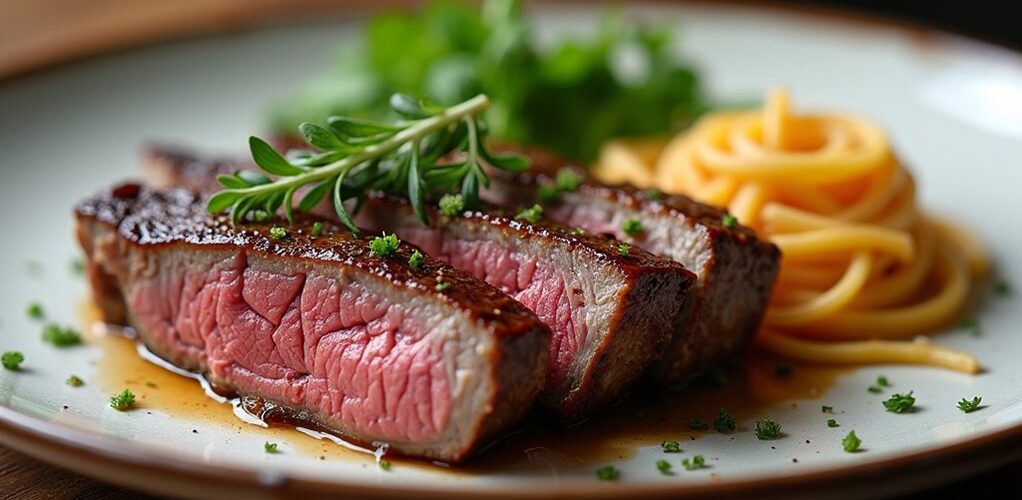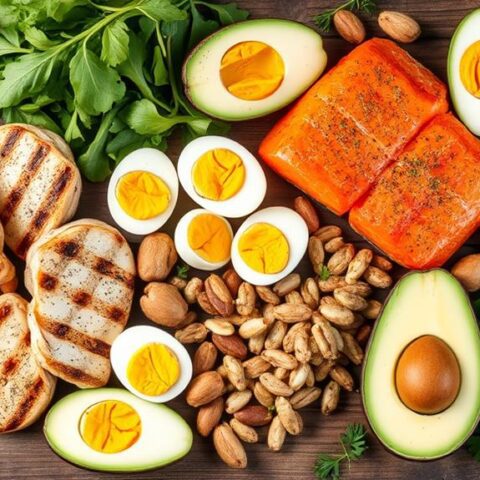
Beef is naturally low in carbohydrates, with most cuts containing zero grams of carbs per 100-gram serving. As a protein-rich food source, beef primarily consists of protein and varying amounts of fat, making it ideal for low-carb and ketogenic diets. While traditional cuts like ribeye and sirloin maintain their zero-carb status, processed beef products may contain hidden carbohydrates from additives. Understanding the distinctions between various cuts and preparation methods reveals beef's full potential in a carb-conscious lifestyle.
Key Takeaways
- Pure beef contains zero to negligible carbohydrates per serving, making it an ideal choice for low-carb and ketogenic diets.
- Unprocessed beef cuts like ribeye, sirloin, and tenderloin contain less than one gram of carbohydrates per 100g serving.
- Beef primarily consists of protein and fats, offering essential nutrients like iron and B12 while maintaining its low-carb status.
- Processed beef products may contain hidden carbs from additives and fillers, so reading labels is crucial.
- Both lean and fatty cuts of beef remain low-carb options, with differences only in their fat-to-protein ratios.
The Carbohydrate Content of Different Beef Cuts
When exploring the world of low-carb nutrition, beef emerges as a cornerstone protein source with remarkably low carbohydrate content. Across various cuts, beef consistently maintains negligible carbohydrate levels, typically containing zero grams of carbs per 100-gram serving.
Fatty cuts like ribeye and brisket offer beneficial fats while maintaining their zero-carb status, making them excellent choices for ketogenic diets. Similarly, leaner cuts such as sirloin and filet mignon provide high-quality protein without adding carbohydrates to one's daily intake.
Whether choosing fatty ribeye or lean sirloin, beef provides essential nutrients while maintaining zero carbs, perfect for ketogenic meal planning.
Ground beef variations, regardless of their fat-to-lean ratios, maintain the same carbohydrate-free profile, though consumers should exercise caution with processed beef products that may contain hidden carbs through added sugars or fillers.
Understanding these variations helps individuals make informed choices while adhering to their low-carb dietary goals.
Understanding Beef's Role in Low-Carb Dieting
As a cornerstone of low-carbohydrate nutrition plans, beef plays a vital role in helping individuals achieve their dietary goals while maintaining essential nutrient intake. The high protein content and zero carbohydrates make beef an ideal choice for those following a healthy low-carb lifestyle, while its rich nutrient profile supports overall wellness.
| Cut Type | Protein (g/100g) | Best Preparation |
|---|---|---|
| Ribeye | 20 | Grilling/Pan-searing |
| Brisket | 21 | Slow-cooking/Smoking |
| Ground (80/20) | 17 | Multiple methods |
When incorporating beef into a low carbohydrate diet, selecting high-quality cuts and proper preparation methods guarantees peak nutritional benefits. The natural combination of protein and healthy fats in beef supports satiety and muscle maintenance, making it an efficient choice for sustainable low-carb eating plans.
Health Benefits of Beef for Carb-Conscious Eaters
Beef provides an impressive array of essential nutrients, including iron for oxygen transport, zinc for immune function, and B vitamins for energy metabolism, making it an excellent choice for health-conscious individuals.
The high-quality protein content in beef supports muscle maintenance and growth, particularly beneficial for those combining low-carb eating with exercise regimens.
Since beef contains virtually no carbohydrates, it helps maintain stable blood sugar levels while providing sustained energy through its protein and healthy fat content.
Essential Nutrients In Beef
For individuals following a low-carb lifestyle, the nutritional profile of beef offers an impressive array of essential nutrients that support overall health and dietary goals. High-quality protein content, ranging from 17-21g per 100g serving, provides all necessary amino acids for muscle maintenance and repair, while essential minerals like iron support oxygen transport and energy production throughout the body.
B vitamins, particularly B12, play an important role in energy metabolism and cognitive function, making beef an excellent choice for those monitoring their carbohydrate intake. The presence of zinc enhances immune function and wound healing, while natural compounds like creatine contribute to muscle strength and brain performance.
Additionally, beef's collagen content supports joint, skin, and digestive health, making it a thorough source of nutrients for health-conscious individuals.
Muscle Growth Support
The protein-rich nature of beef makes it a powerful ally for individuals pursuing muscle development while maintaining a low-carb eating pattern. Its complete profile of amino acids provides the essential building blocks needed for muscle growth and repair, while delivering 17-21 grams of high-quality protein per 100-gram serving.
Beyond protein content, beef's nutritional composition actively supports muscle development through multiple pathways. The abundant zinc content enhances protein synthesis and immune function, facilitating better recovery after resistance training.
Additionally, naturally occurring creatine in high-quality meats supports increased muscle strength during intense workouts. The iron content further aids muscle development by improving oxygen transport throughout the body, enabling more effective training sessions and supporting overall athletic performance.
Blood Sugar Management
When managing blood sugar levels effectively, incorporating lean protein sources becomes essential for maintaining metabolic balance throughout the day.
Beef stands out as an ideal choice for those monitoring their carbohydrate intake, as it contains zero grams of carbs per serving while delivering substantial nutritional benefits. Its high protein content supports blood sugar stability and promotes improved insulin sensitivity through several metabolic pathways.
- Contains zero carbohydrates per 100g serving, preventing unwanted blood sugar spikes
- Provides 20-26g of protein per serving, supporting sustained energy levels
- Rich in iron and zinc, enhancing metabolic function and insulin response
- Promotes satiety, reducing overall carbohydrate consumption throughout the day
The combination of these properties makes beef an excellent choice for individuals following low-carbohydrate dietary protocols or managing blood sugar concerns.
Best Beef Cuts for Ketogenic Meal Planning
Selecting proper beef cuts stands as a cornerstone of successful ketogenic meal planning, with several options offering ideal macronutrient profiles for maintaining ketosis. Beef contains virtually no carbohydrates while being high in fat, making it an excellent foundation for a keto diet.
Ribeye steak leads the selection with its rich marbling, while brisket offers a favorable fat cap for those seeking prime fat content.
For premium keto-friendly choices, ribeye's natural marbling and brisket's generous fat cap deliver optimal nutritional composition in beef selections.
For versatile low-carb meal preparation, ground beef with an 80/20 ratio provides flexibility in recipes while maintaining ketogenic requirements. Sirloin steak serves as a leaner yet flavorful option, and budget-conscious individuals can opt for top round roast, which delivers similar carb-free benefits.
To achieve optimal muscle synthesis, it's important to distribute protein intake evenly across meals, ensuring that beef consumption is balanced throughout the day.
These cuts guarantee sustained nutritional support while adhering to strict ketogenic guidelines.
Hidden Carbs in Processed Beef Products
Many processed beef products harbor unexpected carbohydrates that can derail low-carb dietary goals, despite their meat-based foundation. When following low-carb diets, consumers must carefully examine nutrition labels and ingredient lists, as processed meats often contain hidden carbs from added sugars, fillers, and preservatives.
- Bacon and sausage products frequently include sugar-based curing agents and fillers.
- Pre-packaged deli meats may contain sweet glazes or marinades with significant carb content.
- Beef jerky varieties can include up to 7 grams of carbohydrates per serving from added sweeteners.
- Traditional meatballs and meatloaf recipes incorporate breadcrumbs or other carb-rich binders.
To maintain true low-carb status, selecting minimally processed beef products and reviewing ingredient lists for terms like "no added sugars" becomes essential for successful dietary management.
Nutritional Breakdown of Popular Beef Selections
Raw beef cuts contain virtually zero carbohydrates, with popular selections like ribeye, ground beef, and sirloin offering distinct nutritional profiles suited for low-carb eating plans.
The fat content varies considerably among cuts, from leaner options like sirloin with 10g of fat per 100g serving to richer choices like brisket containing 23g of fat per 100g, while all maintain excellent protein levels between 17-28g per serving.
While grass-fed and grain-fed beef share similar carbohydrate profiles, grass-fed varieties typically offer slightly leaner compositions and different fatty acid ratios, though both remain suitable for low-carb diets.
Beef Cut Carb Content
Pure beef stands as one of the most carbohydrate-friendly protein sources available, with most cuts containing zero grams of carbohydrates per 100-gram serving.
When selecting beef cuts for low-carb diets, it's essential to understand that unprocessed options naturally maintain zero carbohydrate content, while processed beef products may incorporate additional ingredients that affect their carb levels.
- Premium cuts like ribeye, sirloin, and filet mignon contain zero carbs per serving.
- Ground beef varieties typically range from 0-1 gram of carbs per 100 grams.
- Brisket and top round roast maintain their carb-free status.
- Processed beef products, including sausages and meatballs, require label scrutiny due to potential carb-containing additives.
Understanding these variations helps consumers make informed choices when adhering to ketogenic or low-carb dietary requirements.
Popular Cuts Compared
A thorough comparison of popular beef cuts reveals distinct nutritional profiles, despite their shared carbohydrate-free status.
Ribeye stands out as a high fat option, offering rich marbling and zero carbs, while sirloin presents itself as a leaner option without sacrificing flavor.
Ground beef (80/20 blend) provides versatility with its balanced fat-to-protein ratio, making it ideal for various cooking methods.
Brisket delivers tenderness through its substantial fat cap, while filet mignon offers premium protein with minimal fat content.
Each cut, including nutrient-dense beef liver, maintains zero carbohydrates while presenting unique characteristics that cater to different dietary preferences and cooking applications.
This variety allows consumers to select cuts that align with their specific nutritional goals while maintaining a low-carb eating plan.
Grass-Fed Vs Grain-Fed
Beyond the varied cuts available, the distinction between grass-fed and grain-fed beef presents considerable nutritional differences worth considering for health-conscious consumers.
Research shows that grass-fed beef offers several advantages in nutritional composition, particularly in its omega-3 fatty acids content and lower overall fat content compared to grain-fed alternatives.
- Grass-fed beef contains 100-200mg of omega-3 fatty acids per 100g, remarkably higher than grain-fed options.
- The fat content in grass-fed varieties ranges from 10-15%, while grain-fed can reach up to 30%.
- Vitamin E levels are significantly higher in grass-fed beef, offering 2-4mg per 100g.
- Enhanced CLA content provides additional health benefits, including anti-inflammatory properties.
These differences in nutritional profiles make grass-fed beef a compelling choice for those prioritizing nutritional value in their dietary choices.
Grass-Fed vs. Grain-Fed Beef Carb Comparison
When comparing grass-fed and grain-fed beef for carbohydrate content, consumers will find that both varieties contain virtually zero carbs per 100 grams, making either choice suitable for low-carb dietary plans.
While their carbohydrate content remains identical, these two beef varieties differ in other nutritional aspects that may influence dietary decisions.
Grass-fed beef typically offers higher levels of omega-3 fatty acids and essential nutrients like vitamin E and beta-carotene, while grain-fed beef tends to have more overall fat content and calories.
Despite these differences, both options remain excellent choices for individuals following carbohydrate-restricted diets.
The decision between grass-fed and grain-fed beef often depends on factors beyond carb content, such as nutritional preferences, taste considerations, and ethical concerns regarding cattle feeding practices.
Pairing Beef With Low-Carb Side Dishes
Maintaining a low-carb diet requires thoughtful consideration of side dishes that complement beef while keeping overall carbohydrate intake minimal. Several nutrient-rich options provide variety and flavor while supporting healthy fats and effective meal prepping strategies.
- Cauliflower mash serves as a creamy alternative to potatoes, containing only 3 grams of carbs per 100 grams.
- Zucchini noodles offer a fresh texture with minimal carbs, perfect for beef-based pasta alternatives.
- Roasted Brussels sprouts deliver essential nutrients while keeping carbs at 6 grams per 100-gram serving.
- Sautéed spinach and mixed green salads with avocado provide beneficial nutrients and healthy fats while maintaining extremely low carb counts.
Including leafy greens such as spinach or mixed salads in your meals enhances both the nutrient profile and the satiety of the dish, aligning well with keto dietary goals.
These thoughtfully chosen sides guarantee a satisfying low-carb dining experience while maximizing nutritional benefits and maintaining dietary goals.
Cooking Methods That Maintain Low-Carb Status
Direct heat cooking methods, including grilling and pan-searing, excel at preserving beef's naturally low-carb status while creating flavorful crusts and maintaining tenderness. Slow roasting techniques, when combined with low-carb ingredients like herbs and healthy fats, offer an excellent way to develop rich flavors without introducing unwanted carbohydrates. Incorporating healthy oils such as avocado oil allows for high-heat cooking and enhances the nutritional value of beef dishes. These cooking approaches become even more effective when avoiding common high-carb additions such as sugary marinades or flour-based thickeners, instead relying on natural meat juices and permitted seasonings to enhance the final dish.
Direct Heat Cooking Tips
The most effective way to preserve beef's naturally low-carb profile lies in mastering direct heat cooking methods such as grilling, broiling, and pan-searing.
These techniques enhance flavor through caramelization while maintaining the meat's nutritional integrity. Using healthy fats like avocado oil or grass-fed butter complements the beef's rich taste without introducing carbohydrates.
- Select high-quality cuts with good marbling for ideal results when using direct heat cooking.
- Heat cooking surface to the appropriate temperature before adding meat to achieve proper caramelization.
- Avoid sugar-containing marinades and sauces that can compromise the low-carb status.
- Monitor cooking time carefully to prevent overcooking while ensuring a flavorful crust develops.
These methods work particularly well with fatty cuts like ribeye and brisket, helping render fat while maximizing taste.
Slow Roasting Best Practices
Slow roasting transforms beef into a tender, flavorful dish while preserving its naturally low-carb profile through precise temperature control and minimal ingredient additions.
The key lies in maintaining temperatures between 225°F and 275°F, which allows the meat to retain its natural juices and develop rich flavors without requiring carb-heavy marinades or sauces.
For ideal results, enhancing the beef with low-carb herbs and spices like rosemary, thyme, and garlic adds depth without compromising dietary goals.
Monitoring the internal temperature with a meat thermometer guarantees the beef reaches 145°F for medium-rare while preventing overcooking.
After roasting, a 10-15 minute rest period allows juices to redistribute throughout the meat, eliminating the need for high-carb sauces and maintaining the dish's low-carb integrity.
Tracking Macros When Eating Beef
Successfully tracking macronutrients while consuming beef requires careful attention to portion sizes and specific cut selections, as different types of beef offer varying ratios of protein and fat content. Understanding these variations helps optimize dietary goals, particularly for those following low-carb eating plans. Measure portions accurately using a food scale to track protein and fat content, especially since different cuts of meat vary greatly in their macronutrient ratios. Consider the specific cut's fat-to-protein ratio when planning meals – ribeye provides more fat, while sirloin offers leaner protein. Account for cooking methods, as they can affect final nutrient values and caloric content. Reference reliable nutritional databases or product labels for precise tracking, noting that ground beef typically contains 17g protein and 20g fat per 100g. Additionally, incorporating high-protein keto foods such as seafood, eggs, and dairy can complement beef intake, ensuring a balanced and nutritionally complete diet.
Beef Storage Tips for Low-Carb Meal Prep
Proper storage of beef plays an essential role in maintaining its quality for low-carb meal preparation, whether using fresh cuts from the market or frozen portions for later use.
Fresh beef should be stored at temperatures below 40°F (4°C) in the refrigerator's coldest section, while frozen beef can maintain its quality for up to 12 months when properly sealed and labeled.
When preparing beef for storage, using airtight containers or vacuum-sealed bags helps preserve the meat's nutritional integrity and prevents freezer burn, ensuring the beef remains suitable for future low-carb meals.
Fresh vs. Frozen Storage
When planning a low-carb diet that includes beef, understanding proper storage techniques becomes vital for maintaining both quality and safety.
Both fresh and frozen storage methods offer distinct advantages for meal preparation, with proper temperature control being critical for food safety.
- Fresh beef requires refrigeration below 40°F (4°C) and should be consumed within 3-5 days.
- Frozen beef maintains quality for 6-12 months when stored at 0°F (-18°C).
- Proper wrapping in plastic, foil, or vacuum-sealed bags prevents freezer burn.
- Safe thawing requires 24 hours in the refrigerator per pound of meat.
For best results, always label frozen packages with storage dates and rotate stock accordingly.
This systematic approach to beef storage guarantees that low-carb meal prep remains safe and efficient while maintaining the meat's nutritional value.
Safe Temperature Guidelines
Maintaining precise temperature control throughout storage and cooking stands as a cornerstone of safe beef preparation in low-carb meal planning.
Safe temperature guidelines recommend storing raw beef between 32°F and 36°F in the refrigerator, ensuring ideal freshness for up to five days. For extended storage, freezing at 0°F or below preserves beef quality for 6 to 12 months.
When cooking beef, food safety depends on achieving proper internal temperature readings. Using a reliable meat thermometer, whole cuts should reach 145°F, while ground beef requires 160°F to eliminate harmful bacteria.
During thawing, practitioners should utilize refrigeration, cold water submersion, or microwave methods rather than room temperature exposure. Additionally, preventing cross-contamination requires dedicated cutting boards and utensils for raw beef handling, along with thorough hand washing practices.
Selecting Quality Beef for Low-Carb Success
The selection of quality beef plays an essential role in achieving success on a low-carb diet. When cutting through the facts about selecting quality beef, consumers should focus on cuts that naturally contain healthy fats while helping to limit carbs in their daily intake.
- Choose naturally marbled cuts like ribeye and brisket, which provide essential fats for ketosis.
- Select grass-fed beef options for higher omega-3 fatty acids and CLA content.
- Opt for minimally processed beef products to avoid hidden carbohydrates.
- Purchase fatty ground beef blends (80/20) for ideal fat-to-protein ratios.
Incorporating grass-fed beef can also help maintain a healthier omega-6 to omega-3 ratio, which is crucial for balancing inflammation and promoting heart health. Understanding these guidelines helps guarantee that beef selections align with low-carb dietary goals.
Common Myths About Beef and Carbohydrates
Despite widespread misconceptions about beef and carbohydrates, scientific evidence consistently shows that unprocessed beef contains virtually no carbohydrates. Many people incorrectly believe that beef contributes considerably to daily carb intake, but this myth stems from confusion about processed meat products rather than pure beef cuts.
The truth is that natural, unprocessed beef serves as an excellent protein source for those following low-carb diets, containing less than one gram of carbohydrates per 100-gram serving. While some processed beef products may contain added sugars or fillers that increase their carbohydrate content, traditional cuts like ribeye and sirloin remain carb-free. This makes beef an ideal choice for individuals maintaining ketosis or following strict low-carb dietary protocols, provided they select unprocessed cuts and carefully review nutrition labels on processed options. The keto diet is a high-fat, low-carbohydrate dietary approach designed to induce ketosis, where the body burns fat for energy, making beef an excellent fit for this regimen when consumed in its unprocessed form.
Smart Shopping Guide for Low-Carb Beef Options
Successful low-carb beef shopping requires careful attention to product selection and label reading, particularly when traversing the meat department's extensive options.
When seeking ideal low-carb choices rich in healthy fats and protein, consumers should focus on unprocessed cuts while remaining vigilant about hidden carbohydrates in processed options.
- Select pure, unprocessed cuts like ribeye and brisket, which naturally contain zero carbohydrates.
- Choose grass-fed beef options for enhanced omega-3 content and ideal nutritional profile.
- Opt for 80/20 ground beef to maintain perfect fat-to-protein ratios for ketogenic needs.
- Examine labels carefully on processed products to avoid hidden sugars and carb-containing fillers.
Incorporate high-fat dairy products such as cheddar cheese to complement beef meals while maintaining a low-carb diet.
Mindful portion control remains essential, as even perfectly selected low-carb beef products must align with overall dietary goals and caloric requirements.
Frequently Asked Questions
Can I Eat Beef on a Low Carb Diet?
Beef nutrition aligns perfectly with low-carb diets, offering abundant protein benefits without carbohydrates. As one of the best low carb sources, beef provides diet flexibility while supporting nutritional requirements.
What's the Worst Carb for Belly Fat?
Added sugars and refined carbs from processed foods rank among the worst carb types for belly fat accumulation, as their high sugar impact triggers insulin spikes and promotes abdominal fat storage.
Does Beef Break Ketosis?
Beef consumption does not break ketosis, as it contains minimal carb sources. According to dietary guidelines, beef nutrition supports ketogenic goals with its high protein and fat content, maintaining positive ketosis impact.
Why Does Beef Have No Carbs?
Beef naturally contains no carbohydrates because it consists primarily of protein content and fats. As animal meat types, beef's composition focuses on amino acids and proteins, delivering dietary benefits without carbohydrate molecules.
Conclusion
Fresh, unprocessed beef serves as an excellent protein choice for low-carb and ketogenic diets, containing virtually no carbohydrates while offering essential nutrients. While pure beef cuts remain naturally carb-free, consumers should carefully examine processed beef products for hidden carbohydrates from additives and fillers. By selecting quality cuts, storing them properly, and preparing them without carb-heavy additions, health-conscious individuals can confidently incorporate beef into their low-carb lifestyle.










No Comments